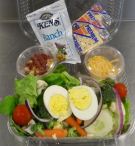 The Healthy, Hunger-Free Kids Act, signed into law in December 2010, charged the U.S. Department of Agriculture (USDA) with updating school food nutrition standards to reflect the latest nutrition science. Updates to the nutrition standards for school meals went into effect at the beginning of the 2012-2013 school year, and schools across the country have been making changes to provide students with healthier choices.
The Healthy, Hunger-Free Kids Act, signed into law in December 2010, charged the U.S. Department of Agriculture (USDA) with updating school food nutrition standards to reflect the latest nutrition science. Updates to the nutrition standards for school meals went into effect at the beginning of the 2012-2013 school year, and schools across the country have been making changes to provide students with healthier choices.
The schools and districts mentioned below are all members of the Alliance for a Healthier Generation’s Healthy Schools Program, which provides training, resources and support to anyone that wants to help transform the conditions and systems that lead to healthier children. The Alliance for a Healthier Generation, founded by the American Heart Association and the William J. Clinton Foundation, works to reduce the prevalence of childhood obesity and to empower kids to develop lifelong, healthy habits.
LIBERAL SCHOOL DISTRICT | LIBERAL, KANSAS
Anticipating that there would be questions and concerns about the new federal school meal regulations that launched this fall, Director of Nutrition Services for Liberal School District Connie Vogts decided to focus on opportunities to educate the community on why the changes were necessary and how they were going to be handled.
Through a lengthy article in the local newspaper, Vogts addressed concerns about limited calories and protein and the needs of student-athletes, unfamiliar fruit and vegetable offerings, and decreased grain and bread portions. She also explained alternate ways that students and parents can have their nutritional needs met if students find the standard school lunch does not meet their personal needs.
Additionally, Vogts continued messaging the why and how of school meals through a bulletin board near the cafeteria entrance. The bulletin board encourages students to read the regulations and to be informed of the changes. With an open door policy, Vogts invited feedback and offered flexibility for the foods that absolutely did not work for students. Switching carrots for mashed sweet potatoes was an easy fix and is just the start of the ongoing discussion between school nutrition professionals and students and parents.
DOVER HIGH SCHOOL | DOVER, DELAWARE
At Dover High School in Delaware, staff report that the students have taken to the new federal school meal regulations with ease and they are enjoying having a wider selection of fruits and vegetables. The Nutrition Services Department has launched eight new soup recipes that are all vegetable based and within the calorie restrictions. The soups have been a hit with the students as the weather is starting to chill and the want for warm and filling food is growing. The word is spreading through the hallways that eating more fruits and vegetables will help you to feel full because of the added nutrients, not calories.
MISPILLION ELEMENTARY SCHOOL | MILFORD, DELAWARE
At Mispillion Elementary, everyone has a role in making sure there is a smooth implementation of the new federal school meal regulations. The physical education teachers are helping to remind students to eat their entire lunch and to bring a healthy snack if they have an afterschool activity or sport. The classroom teachers are getting involved as well. Each grade level has been asked to vote on what vegetable they want to try. Then students and teachers challenge the nutrition services department to create a meal around it. This week they are all eating lentil soup and squash. Since the students were involved in selecting the vegetable, they are more likely to eat the meal.
NORTH MARION SCHOOL DISTRICT | AURORA, OREGON
Nutrition Services Director Lynne Duda reports that her district, North Marion School District, has received positive feedback about their new meal patterns created to meet the new federal school meal regulations. To meet the new regulations they decided to cut back to three entrée choices at each school every day that fit into three categories. One category is Homemade-Healthy, items that are speed scratch cooked. There is a Deli Delight option (sandwich) and an Express choice. All breads and pasta are whole grain and they only offer brown rice.
“We are serving more home-style foods like turkey with gravy and oven-baked chicken and the students are loving it,” said Duda. Before selecting an entrée, every student has to visit the “variety bar” where they can load up on as many fruits and vegetables as they want. Head cook Donna Christenson said, “Some of the trays that the kids bring after visiting the variety bar are so colorful that I wish I could take a picture of them.”
Keltin Boykin, an 11th grader, recently wrote a note to Duda that said, “I really enjoy loading my plate now with all the food that is offered during lunch. I really like the cantaloupe slices and the salad with spinach because I enjoy eating right.”


The views and opinions expressed in this post are those of the author(s) and do not necessarily reflect those of MomsRising.org.
MomsRising.org strongly encourages our readers to post comments in response to blog posts. We value diversity of opinions and perspectives. Our goals for this space are to be educational, thought-provoking, and respectful. So we actively moderate comments and we reserve the right to edit or remove comments that undermine these goals. Thanks!